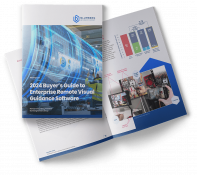Help Lightning Blog
How Extended Reality Solutions Are Transforming Industries

In each era, new technologies emerge with the potential to transform the face of nearly any industry. Although AI technology has been grabbing many of the tech disruption headlines this cycle, it would be a mistake to overlook the many extended reality solutions already augmenting a range of sectors.
What is Extended Reality? An XR Primer
Extended Reality (commonly abbreviated as XR) has become the industry-standard umbrella term to refer to any one of the three primary altered reality technologies: Augmented Reality (AR), Virtual Reality (VR), and Merged or Mixed Reality (MR). These technologies blend the digital and physical worlds in different ways, creating experiences that range from complete immersion in virtual environments (VR), to overlaying digital information or assets on a display of the real world (AR), to an interactive mix of two real-time environments (Merged Reality).
As stated in the scholarly article What is XR? Towards a Framework for Augmented and Virtual Reality (Rauschnabel et al., 2022), “XR should not be used to connote extended reality, but as a more open approach where the X implies the unknown variable: xReality.”
In other words, XR does not denote a specific type of technology, and can be used to refer to any technology within the three branches. As an example, this means that solutions like Help Lightning’s remote visual guidance software (an Augmented Reality technology) can be referred to as XR and/or AR, but not VR.
A Brief History of Extended Reality
Although Extended Reality might seem like a new concept, its origins can be traced back through history to the Renaissance, with Filippo Brunelleschi’s “re-discovery” of one point linear perspective. In fact, the method Brunelleschi developed could even be described as a precursor to visual remote guidance: By holding a hand-held mirror and a painting of a building with a hole in it up to his face (turned around, so as to be reflected in the mirror), he created a system that could verify whether a building’s perspective had been accurately represented in the image – and then correct it if not. Brunelleschi’s revelation would echo throughout history, informing the work of countless artists and architects to come.

Centuries later, stereoscopy emerged as a notable invention which – far predating digital technologies – could be seen as a precursor to modern Extended Reality devices. Like Brunelleschi’s system, the first stereoscopy devices made use of mirrors in their design to reflect an augmented view of reality. Debuted by Charles Wheatstone in 1838, the viewer would look through an eyepiece with a slightly different image reflected on either side, and a flat image would be given the illusion of depth.
Iterations later on in the century like the Holmes Stereoscope would reduce form factor and production cost to the point where the average household could afford to buy their own stereoscopy device – making way for what could be considered the first consumer-grade Extended Reality device.
Extended Reality Glasses in the Modern Era
At the turn of the century, the number of Extended Reality precursors began to pick up speed. Most well-known amongst these, perhaps, was the invention of 3D films, and their accompanying “3D glasses” (cardboard rims with polarized red and cyan gel lenses). Although each prior breakthrough was astonishing at the time, it’s difficult not to marvel at just how far we’ve come – and how quickly we’re still going.
Consumer-grade Mixed Reality for Virtual Reality head-mounted displays (HMDs) has arrived with the Meta Quest 3, just as the Apple Vision Pro promises to bring the tech giant’s polish and knack for user adoption to the Extended Reality market. At the same time, the development of extended reality glasses (commonly referred to as “smart glasses”) is rapidly nearing the ultimate form factor reduction, where the difference at a glance between “regular” glasses and augmented reality glasses may soon be almost indistinguishable.
Emerging Use Cases of XR and AR in Different Industries
From VR headsets allowing users to inhabit fully-digital immersive worlds, to AR applications that require only a smartphone, XR offers innovative yet practical real-world solutions to complex problems. Each year, XR solutions for enterprise use cases and beyond are emerging in new sectors, enabling enhanced training, remote assistance, and collaborative experiences. AR-enabled software solutions like Help Lightning’s are being applied to a wide breadth of industries ranging from healthcare to manufacturing, including remote surgery consultations and visual remote guidance for repairs – the possibilities are virtually endless, and they’re growing by the day.
Extended Reality Solutions for a New Era
The seamless integration of AR is providing companies with innovative ways to work together, regardless of distance. For example, a technician with a pair of AR glasses can connect with someone on the other side of the globe, and guide them through complex processes through an AR overlay, without having to be physically present – saving time and cost between all parties. As technology like Help Lightning’s enterprise-wide software proves, XR is not just about entertainment; it’s also about practical solutions to everyday challenges.
As we continue to explore the intersection of our physical reality with the digital landscape, one thing is clear – extended reality solutions are not just shaping our future, they’re defining it. Want to know what it feels like to hold (Help) Lightning in your hands? Schedule a free demo today!











